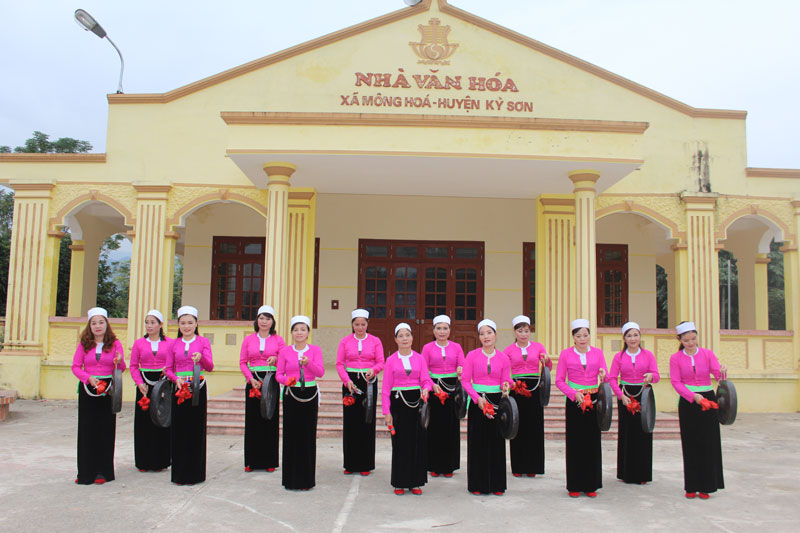
(HBO) – Many generations in Ky Son District’s communes always preserve and promote the outstanding cultural identities of the ethnic people. For them, Gong is not merely a musical instrument but has become a spiritual cultural value which is indispensible in community life.
The artists in Gong club of Du 6 village, Mong Hoa commune (Ky Son) enthusiastically practicing for their performances in the next special occasions and Tet holiday.
Visiting the culture center of Mong Hoa commune in the last days of the year, we met the artist Nguyen Thi Le Sinh who was guiding the members in the Gong club of Du 6 commune to practice for their performances in the upcoming special occasions. At the first glance, a few people can think that she is more than her age of 65. Her hands were so smooth and skillful with each gesture, instructing each member how to beat the Gong properly and how strong was the force needed for the resonant sound. She shared: The club of Du 6 village was established in 2010 with 12 main members, deriving from the passion of the people in the commune towards this kind of national musical instrument. The Gong resonance in each village has become familiar, close and connected to the soul and spirit in culture life of the people here.
On the traditional New Year’s Day, spring festivals, the happy days of the villages, hamlets, clans, cultural or artistic programs of Muong ethnic people here cannot lack the melodious and resonant sound of Gong.
Muong Ethnic people in Ky Son currently preserve their traditional typical culture identities, such as: Gong, Mo Muong ritual, Dum singing, etc. However, the preservation and promotion of the ethnic cultural values of Ky Son District are facing many challenges, which have been caused by the interference effect on the modern life. Therefore, a lot of traditional cultural identities are facing the risk of being lost gradually, and most of cultural values are word of mouth. For that situation, in the past years, in order to grasp thoroughly the people’s awareness about the policy "Culture is the spiritual foundation of the society” and to protect cultural beauty from losing by time, the actions of preservation and promotion of Muong ethnic cultural values is always being taken into consideration by Ky Son District.
The preservation of Gong culture is being exploited effectively. At present, in the whole district, there are 26 Gong clubs with more than 300 artists, mainly perform in special occasions, Tet holiday and important events of the district and the province. Since 2012 up to now, the district has opened many classes to teach Gongs for more than 200 artists in the area. Now, the district keeps 26 Gong sets and more than 500 gongs.
Ms. Dinh Thi Bich Dam, the Vice Head of Ky Son District Culture Board, said that: the district has held some activities like surveys, reviews and evaluation of the real Muong ethnic culture in the local villages and hamlets in order to have specific preservation plans. On special occasions, traditional Tet holiday, especially the Spring Festivals upcoming in the lunar January every year, the district organizes a lot of cultural and artistic activities to preserve folk music and dance of Muong ethnic people or organizes traditional folk games like throwing spindles, Danh Mang (throwing piece of stones), stick pushing and teeter, etc. Besides, the district focuses on propagandizing widely to people, especially the youth so that they can understand, preserve and promote the cultural identity of their ethnic minority.
The People’s Committee of Lac Son district held a ceremony on April 28 to receive the provincial relic certificate for the ancient rock carving site at Suoi Co stream, located in My Thanh commune.
A special music show titled "The country is in the fullness of joy” has been held at Hoa Binh Square in Hoa Binh city in celebration of the 50th anniversary of the liberation of the South and national reunification (April 30, 1975–2025).
The People's Committee of Lo Son commune, Tan Lac district, has organised the local annual traditional stream fishing festival on April 19 - 20.
As a land deeply intertwined with human history and Vietnam’s millennia-long journey of nation-building and defence, Hoa Binh is often revered for its epic tales and legends.
Residents of Hoa Binh boast a rich cultural identity, reflected in their unique language, traditional attire, customs, and folk melodies – described as "sweet as honey, clear as a mountain stream.”
Lac Son district’s Vu ban town held the 2025 Truong Kha temple festival on April 12–13 (the 15th–16th days of the third lunar month). Since its revival in 2019, the festival has been organised every three years, preserving valuable intangible heritage while meeting the community’s cultural and spiritual needs.



